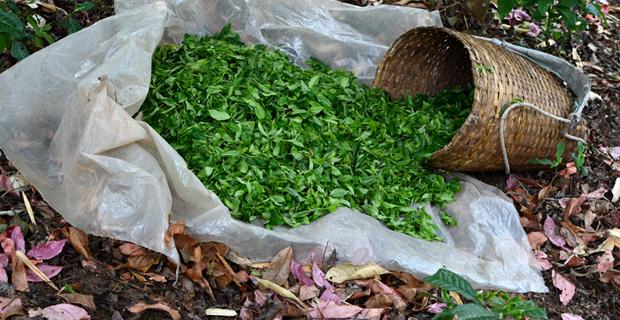How to Make Raw Puer Tea, Step by Step
Raw puer tea processing can make or break a tea. There is a strong parallel between cooking a common breakfast and making puer tea; the preparation and cooking matter as much as the ingredients. Even the most delicious eggs in the world will be ruined if they are full of broken egg shells and burnt by a careless chef. Similarly, it is very easy to take excellent old arbor puer tea leaves and process them into something nearly undrinkable. This is why artful processing is so highly prized; having good ingredients is only half of the battle! This basic introduction will lay out the steps of making raw puer tea from picking the leaves to drying the finished product, maocha [dry loose leaf puer tea].
Step 1. Pick the Leaves
Several preferences exist when picking tea leaves from a tree or bush; different villages or tea buyers will ask that tea be picked in a certain way. While one party may require two leaves and a bud, another may desire only one bud, while a third asks for a bud plus four leaves. The differences in the leaves picked will affect the outcome of the final product. Buds have a character which is different from stems which is different from the larger, older leaves. At White2tea we make cakes with every piece in order to produce puer tea with greater depth and a range of characteristics.
Step 2. Withering
The fresh leaves are scattered on a mat and left to wither for several hours prior to the next step. The amount of time depends on the producer and their desired results. Withering for a longer period of time, such as six hours or more, will decrease astringency.
Step 3. Kill Green [Sha Qing]
During this step, the slightly withered leaves are put into a wok and fired in order to "kill green". Different villages and ethnic minority groups in Yunnan prefer different temperatures and amounts of time in the wok, which will produce a variety of different results. There is no perfect time to cook an egg, simply a difference of opinion or desired results. However, most everyone will agree on what is severely over or under cooked. During this step, some factories will use a large machine to process the tea while processing by hand offers more control.
Step 4. Rolling (Rou Nian)
After the cooked leaves have cooled, they are rolled into order to bruise the leaves and break down the cell walls. Sometimes this is done by hand and sometimes it is done by machine like the one pictured above. Hand rolled leaves tend to be much looser, compare to machine rolling which produces a tighter roll.
Step 5. Sun Drying (Shai Gan)
After the rolling process, the leaves are scattered out evenly on bamboo mats for drying in the sun. In some factories, rather than sun drying, they will place the leaves in a room with heat or use other heating devices to dry out the leaves.

